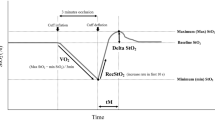Abstract
Major amputation is unavoidable if revascularization is not possible in critical limb ischemia with nonviable limb. Good perfusion is imperative to achieve uneventful wound healing. This case series analysis evaluated the use of laser Doppler flowmeter and tissue spectrometer (O2C®) in assessing tissue perfusion before and after a major lower limb amputation. Forty patients with an indication for a major lower limb amputation were from March 2018 to January 2020 recruited. O2C® measurement was performed at pre-defined points along the transection line and at pre-designated points of reference before and after surgery. Analysis of variance was carried out for repeated measurements. The correlation of three different O2C® parameters with wound healing was analyzed. After exclusion of 3 patients, 37 patients remained for evaluation. Twenty-three patients (62%) had uneventful wound healing, 9 patients (24%) had a minor healing disorder, whereas 5 patients (14%) needed surgical re-intervention. Few correlations between the O2C® parameters and wound healing could be demonstrated. These included the preoperative oxygen saturation in the thigh area before a thigh amputation (p = 0.0157). The blood flow rate correlated with wound healing on the thigh preoperatively during knee disarticulation (p = 0.0349). Marked variability in the measured values over various points in time was noted. With the exception of the oxygen saturation and flow parameter on the thigh, none of the other O2C measurements predicted wound healing after a major lower limb amputation. O2C® is of minor value to assess tissue perfusion before a major limb amputation.



Similar content being viewed by others
References
Wozniak G, Baumgartner R (2020) Prinzipien der Amputation in der Gefäßchirurgie. In: Debus ES, Gross-Fengels W (eds) Operative und interventionelle Gefäßmedizin. Springer Berlin Heidelberg, Berlin, Heidelberg, pp 303–317
Spoden M (2019) Amputationen der unteren Extremität in Deutschland – Regionale Analyse mit Krankenhausabrechnungsdaten von 2011 bis 2015. Das Gesundheitswesen. 81. https://doi.org/10.1055/a-0837-0821
Althani H, Sathian B, El-Menyar A (2019) Assessment of healthcare costs of amputation and prosthesis for upper and lower extremities in a Qatari healthcare institution: a retrospective cohort study. BMJ Open 9:e024963. https://doi.org/10.1136/bmjopen-2018-024963
Hepp W (2001) Amputationen. In Hepp W, Kogel H (Hrsg) Gefäßchirurgie, Urban & Fischer, München Seite 515-524.
Wunder C et al (2005) A remission spectroscopy system for in vivo monitoring of hemoglobin oxygen saturation in murine hepatic sinusoids, in early systemic inflammation. Comp Hepatol 4(1):1
Walter B et al (2002) Simultaneous measurement of local cortical blood flow and tissue oxygen saturation by Near infra-red Laser Doppler flowmetry and remission spectroscopy in the pig brain. Acta Neurochir Suppl 81:197–199
Sommer N, Taguchi NSA, Kurz A (2002) Tissue oxygen supply determined by microvascular oxygen saturation (SO2), blood flow (BF) and subcutaneous tissue pO2 (PsqO2) during whole body heating and Normobaric hyperoxia in healthy volunteers (Abstract), Presentation Ulm
Fournell A, Scheeren TW, Schwarte LA (2003) Simultaneous assessment of microvascular oxygen saturation and laser-Doppler flow in gastric mucosa. Adv Exp Med Biol 540:47–53
Coerper S, Becker SCWHD (2003) Evaluation des Mikrolichtleiters und Spektrophotometers (O2C) zur Erfassung und Quantifizierung der Ischämie im Rahmen der Heilung ischämischer Wunden, Chirurgische Universitätsklinik, Klinik für allgemeine Chirurgie, Tübingen; Vasomed
Darwich I et al (2019) Spectrophotometric assessment of bowel perfusion during low anterior resection: a prospective study. Updat Surg 71(4):677–686
Löffelbein DJ (2005) Noninvasives Monitoring mikrovaskulärerTransplantate mit Hilfe der simultanen Laser-Doppler-Spektrometrie.
Kapust J (2016) Mikrozirkulation der Haut in pAVK-Patienten im Stadium IV nach Revaskularisation - eine Angiosomkonzept basierte Auswertung mittels O2C
Dowd GS (1987) Predicting stump healing following amputation for peripheral vascular disease using the transcutaneous oxygen monitor. Ann R Coll Surg Engl 69(1):31–35
Fife CE et al (2009) Transcutaneous oximetry in clinical practice: consensus statements from an expert panel based on evidence. Undersea Hyperb Med 36(1):43–53
Zingg M et al (2019) Transcutaneous oxygen pressure values often fail to predict stump failures after foot or limb amputation in chronically ischemic patients. Clin Surg: 1–6
Krug A (2007) Mikrozirkulation und Sauerstoff-versorgung des Gewebes, Methode des so genannten O2C (oxygen to see). Phlebologie 36:300–312. https://doi.org/10.1055/s-0037-1622158
Harrison DK et al (1995) Amputation level assessment using lightguide spectrophotometry. Prosthet Orthot Int 19(3):139–147
Beckert S et al (2004) The impact of the micro-lightguide O2C for the quantification of tissue ischemia in diabetic foot ulcers. Diabetes Care 27(12):2863–2867
Tanzer TL, Horne JG (1982) The assessment of skin viability using fluorescein angiography prior to amputation. J Bone Joint Surg Am 64(6):880–882
Burnham SJ et al (1990) Objective measurement of limb perfusion by dermal fluorometry: a criterion for healing of below-knee amputation. Arch Surg 125(1):104–106
Zimmermann A et al (2010) Early postoperative detection of tissue necrosis in amputation stumps with indocyanine green fluorescence angiography. Vasc Endovascular Surg 44(4):269–273
Yang AE et al (2018) Improving outcomes for lower extremity amputations using intraoperative fluorescent angiography to predict flap viability. Vasc Endovascular Surg 52(1):16–21
Author information
Authors and Affiliations
Corresponding author
Ethics declarations
Competing Interests
The authors declare no competing interests.
Additional information
Publisher’s Note
Springer Nature remains neutral with regard to jurisdictional claims in published maps and institutional affiliations.
Rights and permissions
About this article
Cite this article
Rustanto, D., Darwich, I., Friedberg, R. et al. Significance of Transcutaneous Spectrophotometric Oxygen Measurement Using Oxygen to See (O2C®) in Major Lower Extremity Amputations. Indian J Surg 85 (Suppl 1), 189–198 (2023). https://doi.org/10.1007/s12262-022-03472-7
Received:
Accepted:
Published:
Issue Date:
DOI: https://doi.org/10.1007/s12262-022-03472-7




